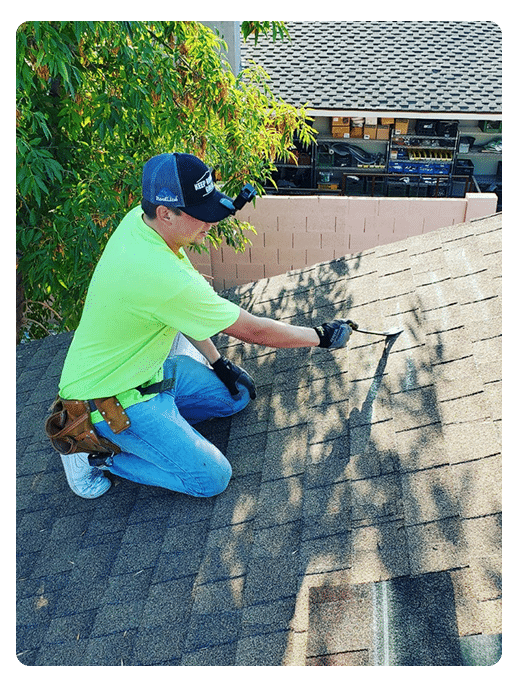Roofing issues can be an intimidating issue for many homeowners. With the right knowledge, however, common roofing problems can be identified and remedied quickly.
This article will provide an overview of decoding common roofing issues and offer insight into how to identify them as well as possible solutions.
The first step in understanding how to decode a roofing problem is understanding what signs indicate that there may be a potential issue present.
From there, it is important to understand the typical causes of certain types of roofing damage so that appropriate steps can be taken to remedy the situation.
By taking this approach and properly identifying any underlying issues, homeowners will have the tools they need to ensure their roofs are safe and secure.
Identifying Potential Roofing Issues
Roofing issues are complex, and they can come in many different forms. It is essential to identify any potential problems as soon as possible in order to prevent further damage or costly repairs down the line.
To that end, it is important for homeowners and building managers to be aware of some of the most common roofing issues.
The first step in identifying potential roofing issues is visual inspection from the ground level. This should include looking for missing shingles, sagging gutters, and signs of water pooling around the base of the house or commercial building.
Additionally, a professional inspector may need to climb onto the roof itself to check for areas where granules have been worn away from wind or hail storms; gaps between flashing on chimneys, vents, and other protrusions; shingle tabs that are curling up at the corners; loose nails; or an overall lack of structural integrity.

Assessing The Severity Of The Damage
Once a potential roofing issue has been identified, it is important to assess the severity of the damage. To do this, an experienced professional should be consulted who can adequately inspect and evaluate the full extent of the problem.
A variety of factors need to be taken into account in order to accurately gauge the magnitude of repair or replacement work needed for a successful resolution. The assessment process includes evaluating any existing materials that are still intact as well as examining possible sources of infiltration.
It also involves inspecting underlying structural components such as decking, sheathing, trusses and other related elements that may have been compromised by water intrusion or wind damage. During this evaluation stage, all existing conditions must be documented so that any necessary repairs can begin without further delay.
Adequate ventilation needs to be considered if mold growth is discovered along with checking air flow within the attic space itself. In addition, insulation levels should be evaluated since they play an integral part in achieving optimal energy efficiency throughout the home.
Investigating Common Causes Of Roofing Damage
The roof of a house is an integral part of its structure, and as such requires regular maintenance to prevent damages from occurring.
This article will investigate the common causes of roofing damage, which can include anything from extreme weather conditions to poor installation techniques or materials.
Extreme weather conditions such as heavy snowfall, high winds and hail are some of the most common causes of roofing damage.
Roofs that are not properly installed may also be susceptible to leaks due to gaps between panels or improper sealing around vents and flashing.
Poor quality materials used in construction may cause premature deterioration if they do not meet minimum industry standards for strength and durability.
Additionally, exposure to direct sunlight over time can weaken and degrade certain types of asphalt shingles, resulting in curling or cracking.
Regular inspection by a qualified professional is recommended in order to identify potential problems before they become larger issues.
By addressing small repairs early on, homeowner’s can protect their investment while avoiding more costly repairs down the line.
Without proper care and attention, roofs are prone to developing serious structural problems which could result in complete replacement being necessary.
Understanding Different Types Of Roofing Materials
In order to gain a better understanding of roofing issues, it is essential to investigate the different types of materials used in roof construction.
Whether you are considering an asphalt shingle roof or something more traditional like clay tile, there are numerous factors that influence the durability and functionality of your roofing system.
It is important to weigh all options before making any decisions about which type of material best fits your situation.
One factor that should be given serious consideration when choosing between various roofing materials is climate.
Certain products perform well in wet climates while others may be better suited for arid regions.
Additionally, some materials can withstand high winds and hail whereas other will require regular maintenance and repairs due to their vulnerability during extreme weather conditions.
Furthermore, certain design features such as steep pitches or valleys must also be taken into account when selecting the right material for a specific location.
It is clear that careful consideration must be taken when deciding on a particular type of material for your roof installation project.
Understanding the advantages and disadvantages associated with each option can help homeowners make an informed decision that meets both their budget needs and long-term goals.
Taking into account local environmental considerations along with structural design requirements will ensure the most successful outcome possible from your new roof installation project.
Evaluating The Benefits Of Professional Roofing Services
A thorough roof inspection is an essential step to ensure that any existing or potential roofing issues are discovered and addressed. Professional roofing services can provide a comprehensive analysis of the condition of your roof, as well as detailed information about materials used in construction, age of the system, ventilation effectiveness and overall condition.
By engaging such professionals to inspect the roof, homeowners can gain peace of mind knowing all major components have been inspected for damage, wear and tear.
In addition to providing valuable insight into present problems with the roof structure, professional roofers can also offer advice on preventative maintenance measures which may help extend the life of the roof before costly repairs or replacement become necessary.
This could include upgrading insulation levels if needed to create better energy efficiency and control condensation within attic spaces; checking chimney caps, valleys and flashing; verifying proper vent installation; adding new shingle layers; and cleaning debris from gutters and downspouts.
Taking proactive steps now can save considerable time, money and hassle later on down the road.
Exploring Diy Roofing Solutions
DIY roofing solutions can be both a cost-effective and quick way to fix common issues. However, it is important to note that not all roof repairs are suitable for DIY repair and some may require the expertise of a certified professional.
There are several factors to consider when deciding if you should attempt a DIY solution or hire a contractor. These include the extent of the damage, your experience level with construction work, availability of materials needed for repair, safety considerations, and local building codes.
While attempting DIY roofing projects gives homeowners an opportunity to save money in some cases, there are also risks involved. Even simple tasks such as replacing broken shingles can become more complicated after beginning the project due to unforeseen circumstances like discovering rot or damaged decking underneath existing shingles.
Additionally, improper installation techniques could void warranties on certain products and result in costly repairs down the line. Therefore, it is essential that homeowners carefully assess their skills before undertaking any major DIY roof repair projects and proceed only if they have sufficient knowledge and experience in this area.

Taking Preventative Measures To Protect Your Roof
It is important to stay ahead of roofing issues and take preventative measures to protect your roof. The most effective way to do this is by regularly inspecting the roof for any signs of damage or wear, as well as developing a maintenance plan that includes regular cleanings and repairs.
Inspections should be conducted at least twice a year, but more frequently in areas with extreme weather conditions or if the roof has experienced storm damage. During inspections, look closely for water stains on walls and ceilings, missing shingles, sagging gutters, cracked caulk around vents and chimneys, moss growths, damaged flashing, and other warning signs that can indicate a potential problem.
For routine maintenance such as cleaning debris off the roof or removing moss growths, it is always recommended to hire an experienced professional who knows how best to carry out these tasks safely and efficiently.
Additionally, you should check all seals around pipes and chimney flues every few years to make sure they are still providing adequate protection against leaks. It may also be beneficial to apply protective coatings or sealants over certain parts of the roof periodically in order to extend its lifespan.
Taking these steps now will help reduce costly repairs down the line.
Conclusion
In conclusion, roofing issues can be identified and assessed to determine the severity of the damage.
Common causes such as weather conditions or improper installation should be investigated in order to create an effective repair plan.
Different types of roofing materials have varying levels of durability that must be taken into account when making a decision on how best to proceed with repairs.
Professional services may offer additional benefits compared to DIY solutions but it is also important to keep up with preventative measures over time in order to protect your roof from future damage.
Taking these steps will help ensure that any potential risks are mitigated and the longevity of your home’s roof is enhanced.


